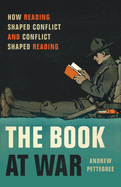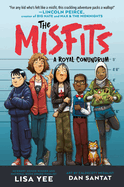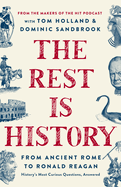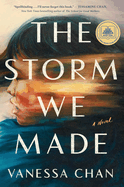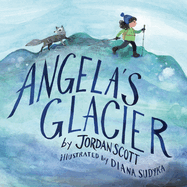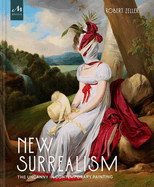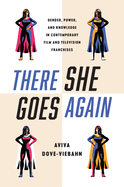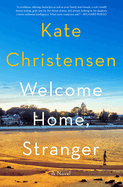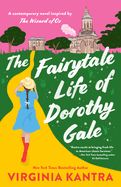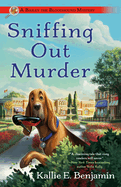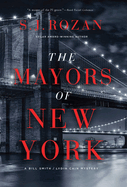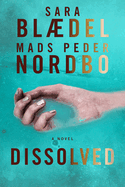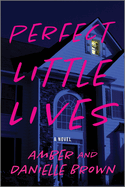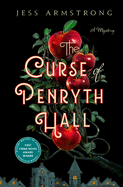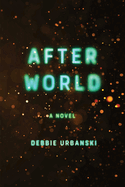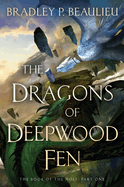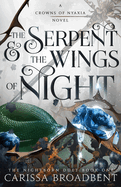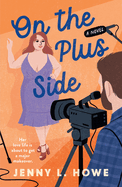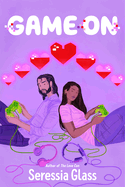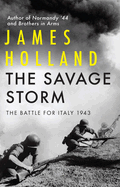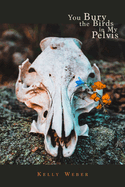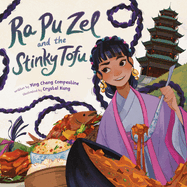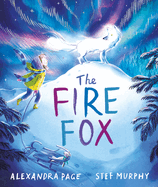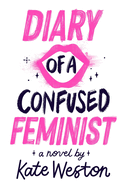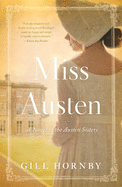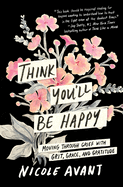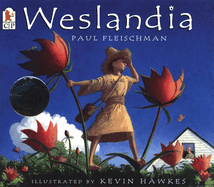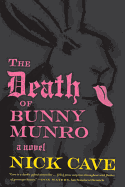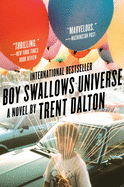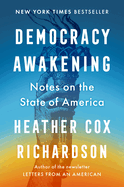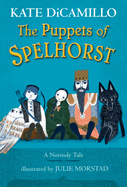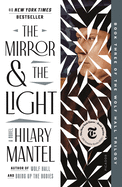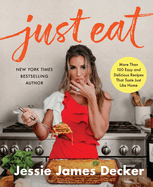Friday, January 5, 2024
This week, we feature some terrific nonfiction to kick off the New Year: The Book at War by Andrew Pettegree, "perfect for lovers of history and literature," and appearing at a time when book bans are prevalent, explores how books have been used during dire times; The Rest Is History by historians and podcast hosts Tom Holland and Dominic Sandbrook, a companion book to their popular podcast of the same name, "cheekily explains curious and weird moments in human history." And Lisa Yee and Dan Santat team up for the middle-grade A Royal Conundrum--"action, adventure, and fun with a heartening group of young underdogs" who solve crimes.
Don't miss The Writer's Life: Vanessa Chan discusses her debut novel, The Storm We Made (reviewed in this issue), and how she coaxed memories from her grandparents about the World War II Japanese occupation of Malaya (now Malaysia).
The Storm We Made
by Vanessa Chan
In her outstanding debut novel, The Storm We Made, Malaysian American author Vanessa Chan depicts a wartime that is both extraordinary and quotidian at once. Her storytelling is crisp and bracing, without overlooking the profound complexities of events leading up to the Japanese occupation, as the novel explores every which way that the lives of one family in Kuala Lumpur are upended in the aftermath.
It's 1945, and the consequences of Cecily Alcantara's private choices are being borne out on a terribly global scale. But, worst of all, her son, Abel, has gone missing, on his 15th birthday. He's one in a string of disappearances--all teenage boys, all part of the smothering presence of the Japanese forces that replaced the British colonizers who had occupied Malaya before them. All the result of an affair that Cecily had begun in 1934 with Shigeru Fujiwara, a Japanese spy.
Chan showcases dazzling stylistic flair as she alternates between timelines, blending thematic touches of thrilling spy craft and domestic drama within the outlines of this spellbinding historical novel. And although Cecily blames herself for how unfortunately these events transpire, Chan makes clear the hope of prosperity that this unhappy housewife foresaw when she first entangled herself in Fujiwara's web of deceit and empty promises. "From the beginning, Cecily and Fujiwara had talked about a world in which Asians could determine their own future."
Profound in its empathy and devastating in its consequences, The Storm We Made considers the deeply personal implications of a world at war, and makes Vanessa Chan's first novel an unforgettable glimpse at how extraordinary times fall upon ordinary people. --Dave Wheeler, associate editor, Shelf Awareness
Discover: With dazzling flair, Vanessa Chan delivers a heart-stopping wartime novel in which one woman feels the weight of the world bearing down on her.
Welcome Home, Stranger
by Kate Christensen
Rachel, a self-described "middle-aged childless recently orphaned menopausal workaholic journalist," returns to Portland, Maine, after her mother's death, where she faces guilt, her sister Celeste's resentment, and complex feelings for a long-time lover. In Welcome Home, Stranger, Kate Christensen's eighth novel (The Last Cruise; How to Cook a Moose; Blue Plate Special), Rachel is a likable protagonist who inspires sympathy for her lonely and dreaded return to her past.
The sisters concede that it's too late to mourn their mother, whose lifetime of narcissism and competition with them, "pretending to be motherly with cloyingly caustic swipes," included angrily dismissing Rachel just a decade earlier. Celeste--settled in town with her husband, heir to Maine old money--unreasonably resents her sister for not being there at the end and for inheriting their mother's town house. This "unasked-for burden of a gift" demands Rachel's attention, a distraction from personal upheaval back in D.C., which includes a career impasse as a dedicated environmental journalist, and grief over the physical decline of her former husband, with whom she amicably shares a home. Rachel, tempted by the now-married love of her life, juggles this onslaught of emotional challenges with wit and a generosity of spirit.
With effort, the sisters defuse the rivalry their mother fostered, reaching a fragile détente. Although Rachel had dismissed Maine to "a dark northern blot on the map," it's a perilous episode in the northern woods that clarifies her future in this sophisticated, witty novel of midlife reflection and acceptance. --Cheryl McKeon, Book House of Stuyvesant Plaza, Albany, N.Y.
Discover: Called home to Maine from Washington, D.C., when her estranged mother dies, a woman stoically faces her unhappy past and an uncertain future.
The Fairytale Life of Dorothy Gale
by Virginia Kantra
Virginia Kantra (Meg and Jo; Beth and Amy), author of more than 20 novels, has reimagined themes and characters from Little Women, the classic by Louisa May Alcott. In The Fairytale Life of Dorothy Gale, Kantra once again puts a fresh, contemporary spin on a beloved story--this time The Wizard of Oz--via the creation of another Dorothy from Kansas who sets out on a modern yellow-brick-road quest of her own.
The "storm" that sets Dorothy "Dee" Gale's life in motion involves the heart. Her life falls apart when, as a 26-year-old grad student, she falls for a charismatic adjunct writing professor, who later publishes a novel detailing the couple's fraught relationship. Brokenhearted and eager for a fresh start, Dorothy sets off to Trinity College in Ireland to finish her master's degree--and a book of her own. Along the way, she meets others facing challenges reminiscent of characters from The Wizard of Oz: Reeti Kaur, a Sikh from Punjab, India, who lacks courage to stand up to her family expectations; Sam Clery, a responsible son and newsagent, who thinks he's too old (and it's too late) to go to college; and Tim Woodman, a jaded, risk-averse businessman with a broken heart. Each person faces obstacles on the road to personal fulfillment. Might love also be on the horizon?
Smart, inventive Kantra delivers another craftily plotted adventure where an updated cast of immensely likable characters ultimately inspires and empowers one another's lives. --Kathleen Gerard, blogger at Reading Between the Lines
Discover: The Fairytale Life of Dorothy Gale is an inventive, updated retelling of The Wizard of Oz that explores modern life's obstacles and the search for a place in the world.
Mystery & Thriller
Sniffing Out Murder
by Kallie E. Benjamin
Sniffing Out Murder is the first in a pleasurable new cozy mystery series by Kallie E. Benjamin, who also writes mysteries under the names Valerie Burns (Murder Is a Piece of Cake) and V.M. Burns (Bookclubbed to Death).
Priscilla "Pris" Cummings returns to her "nothing much happens" hometown of Crosbyville, Ind., to care for a beloved aunt. Choosing to stay on, Pris takes a job as an elementary school teacher. The 28-year-old, feeling unfulfilled, writes and publishes a middle-grade mystery novel that becomes so successfully received that Priscilla decides to leave teaching and devote herself to writing full-time. Her crime fiction series features a pet detective--stories spun from the inquisitive antics of her own three-year-old bloodhound, Bailey, a registered therapy dog.
Just as Priscilla is gladly wrapping up her last day at school, a parent-teacher conference unexpectedly escalates. A parent storms out after receiving feedback on her daughter's progress and--being an insecure, bullying school-board member--she threatens to cut off a reading program that would impact Pris, Bailey, and their books.
The next day, while Pris is walking Bailey at the park, the dog digs up a corpse: the body of the bullying parent. This shocking discovery implicates Pris and Bailey, and leads them to solve a real-life murder mystery.
Benjamin's suspenseful cozy will charm mystery fans who enjoy small-town characters and culprits--and enough red herrings to throw pet detectives and readers off the scent of a killer. --Kathleen Gerard, blogger at Reading Between the Lines
Discover: A briskly paced cozy mystery about a teacher-turned-writer and her Bloodhound muse who get swept up in a small-town murder investigation.
The Mayors of New York
by S.J. Rozan
Jaded, morally challenged adults can make formidable adversaries, but then so can run-of-the-mill teenagers. The pool of potential baddies is doubly deep in S.J. Rozan's The Mayors of New York, another brisk, droll, and diverting title in the Lydia Chin/Bill Smith mystery series.
Private investigator Bill Smith narrates Rozan's follow-up to Family Business: he's been approached by Bree Hamilton, top aide to the mayor of New York, who also happens to be Bill's ex-girlfriend. (She figures she can trust him.) Bree wants Bill to find Mark McCann, the mayor's missing 15-year-old son. Bree is certain that Mark wasn't kidnapped: not only does he have a history of running away, but it's clear that he disarmed and reactivated the family's alarm system before he left home two nights earlier. The mayor can't go to the police, of course, because then, says Bree, "her political capital takes a hit because she looks like a bad mother."
Lydia Chin, Bill's partner in both senses, also works the case, which becomes more complicated when Lydia realizes that a suspicious suicide she was asked to look into concerns one of Mark's friends. Inevitably, The Mayors of New York has its share of Gotham-style politics and, as ever, the series offers a sightseeing tour of the Big Apple. This time around, Bill touches down in four out of five boroughs, but the most New-Yorky scene has got to be--in a dazzling display of local color--a brawl featuring Superman, Elmo, and other costumed characters of Times Square. --Nell Beram, author and freelance writer
Discover: This offering in the brisk, droll, and diverting Lydia Chin/Bill Smith mystery series finds Bill hired to locate the mayor of New York's missing 15-year-old son.
Dissolved
by Sara Blaedel and Mads Peder Nordbo
Veteran crime queen Sara Blaedel (A Harmless Lie; The Drowned Girl) teams up with Mads Peder Nordbo (Cold Fear) in the creepy and enthralling Dissolved. A young mother goes missing after her morning workout, and her distraught husband can't get the local Danish police to begin an investigation until precious time has already passed. A second resident goes missing shortly afterward while his grandmother waits at his apartment. An elderly man vanishes while walking his dog. And so it continues. There seems to be no connection between the victims, other than that they have all received a note bearing some kind of religious verse, initially thought to be from the Quran, that might hint at why they have been targeted.
Detectives Liam, Dea, and Nassrin (the latter a relative newcomer to the police force) all have a personal stake in the number of people who go missing from their town--and that list comes ever closer to home. Nassrin grows increasingly frustrated at the all-too familiar ways in which the Muslim community, which includes her family, always seems to be among the first under suspicion. Soon, hidden conflicts come to the surface among the police officers.
Blaedel and Nordbo carefully establish the relationships and tension in the first part of the book and then quicken the pace in an all-out race to solve the case and salvage whatever they can from the clutches of a criminal whose level of cruelty is shockingly novel. --Elizabeth DeNoma, executive editor, DeNoma Literary Services, Seattle, Wash.
Discover: This chilling thriller presents a race-to-the-finish hunt for an elusive killer who seems to know everything about their victims.
Perfect Little Lives
by Amber and Danielle Brown
Amber and Danielle Brown (Someone Had to Do It) present their second thriller, Perfect Little Lives, a shocking murder mystery with a twist of steamy romance that captures the essence of love, loyalty, and corruption. The Brown sisters perfectly blend a large dose of secrets and lies with pungent social commentary in this twisted novel of affairs, family, and murder
Simone's childhood in the affluent and primarily white neighborhood of Asher Lane came to a screeching halt when her mother went missing--and her father was convicted of her murder. Given a lack of concrete evidence and the community's underlying racial bias, Simone struggles to uncover the truth and exonerate her father.
Simone runs into Hunter Bishop, her old Asher Lane neighbor and childhood best friend, and learns that Hunter's father had a long-term affair with her mother. As she unveils their parents' many secrets, using Hunter to get closer to the truth, Simone begins to put pieces of the puzzle into place--and considers a new suspect. Her anger toward the unquestioned ruling against her Black father by a prejudiced white community leads her to twisted theories, dangerous confrontations, and possible closure. However, Simone must decide how much of her new life she is willing to risk in order to set the record straight. And she doesn't merely find new clues: she and Hunter, who learn it is hard to leave their pasts in Asher Lane, discover a future built on truth and trust. Perfect Little Lives is thrilling, revealing, and relevant. --Clara Newton, freelance reviewer
Discover: The Brown sisters present a thriller that combines a darkly sexy romance and deeply aware social commentary.
The Curse of Penryth Hall
by Jess Armstrong
Life in England, post-World War I; interest in the supernatural; and the "bleak and beautiful" Cornish countryside, "full of secrets and legends," meld into a fascinating plot in The Curse of Penryth Hall, the winner of Minotaur Books/Mystery Writers of America's First Crime Novel Award. Jess Armstrong's debut relies heavily on its evocative gothic atmosphere, aided by a rich sense of history with an intriguing, strong heroine to guide the plot.
For the past four years, U.S. expat Ruby Vaughn has lived with the eccentric octogenarian Mr. Owen in his derelict mansion in Exeter, Devon, running his bookstore, looking after him, and acting more like his daughter than an employee. In turn, he sends Ruby on adventures that he can't take anymore. The latest is delivering a box of rare books to a folk healer in a tiny village in Cornwall, an area she prefers to avoid. The trip brings Ruby in contact with her former best friend and lover Tamsyn Chenowyth, now married to Edward, wealthy lord of Penryth Hall. Villagers believe Penryth's curse has returned when Edward's disfigured body is found in the orchard, followed by the hall's bells ringing for the first time in 30 years. Skeptical Ruby teams up with the local "pellar," or witch, to solve the murder and help her friend.
Armstrong's lively prose will make cynics believe in curses and witches. Ruby's intelligence, insight, fearless nature, and complicated background will make readers eager for a sequel. --Oline H. Cogdill, freelance reviewer
Discover: The employer of an American living in post-World War I England sends her on intriguing adventures throughout the country in this stellar start to a series.
Science Fiction & Fantasy
After World
by Debbie Urbanski
In the near future of After World, Debbie Urbanski's debut novel, the climate crisis necessitates a level of drastic action that has been thus far contained to the postapocalyptic novel (both in reality and on a meta self-referential level within the novel). When humanity asks for solutions, an AI suggests eradication of the problem: humans. This is ostensibly rejected: "No one and nothing would ever trigger human extinction to save the planet, people believed." But, ultimately, a debilitating virus spreads as resources dwindle and regulatory efforts shift to facilitate the demise of the human populace--with minimal additional impact on the earth and its nonhuman inhabitants.
The novel's primary focus is Sen, the last human and chosen witness to how the world she was promised will continue without her as she slowly dies: "She is solitary and respiratory and mammalian and alone" as she logs her observations in drone-provided notebooks. Storyworker ad39-393a-7fbc, a digital presence that appears "outside their field of vision as an imperceptible wariness," relays Sen's life and must upload Sen to Maia, the virtual reality where humans will be archived. But the storyworker cannot stay unaffected by Sen. As their stories converge, Urbanski invites readers to consider if it's possible to engage with existential questions about worth and legacy without considering cost and consequences.
The questions at the heart of After World are desperate and unanswered, but the novel's sadness never gives over to issuing judgment, instead suggesting limits to the allure of the postapocalyptic novel with a heavy dose of believable global peril. --Kristen Coates, editor and freelance reviewer
Discover: After World is a postapocalyptic debut that blends concerns about AI and the climate crisis with perpetually human questions about meaning and legacy.
The Dragons of Deepwood Fen
by Bradley P. Beaulieu
Unlikely allies discover a dangerous plot in The Dragons of Deepwood Fen, the enjoyable first entry in the Book of the Holt series by Bradley P. Beaulieu (A Desert Torn Asunder).
Brilliant inquisitor Lorelei Aurelius stumbles into a mysterious connection between the rebel group the Red Knives and the Church. Rylan Holbrooke, thief and clandestine dragon singer, is unwillingly drawn into a Red Knives plot. In order to stop a chain of events that could topple the empire, Lorelei must free Rylan and they must flee the city together as traitors.
Beaulieu presents a world that will please fans of traditional epic fantasy, one full of empires, intrigue, and dragons, but showcased through more points of view than may have been strictly necessary. Although some characters appear and disappear more quickly than expected, because of the attention given to their perspectives, they will all endear themselves to readers, particularly the two leads. Rylan is a classic fantasy archetype--the illegitimate son of nobility, a permanent outsider who nonetheless may hold the fate of empires in his hands. Lorelei offers a welcome streak of neurodiversity: although it doesn't seem this fantasy world has a word for whatever her specific neurodivergence is, Beaulieu respectfully portrays her challenges, such as discomfort with crowds and suggestions of more intense difficulties in her childhood, as part of her character. More than anything, these two make this novel stand out in the world of fantasy adventure.
Fans of Brandon Sanderson will be eager to explore this series. --Kristen Allen-Vogel, information services librarian at Dayton Metro Library
Discover: An endearing pair of unlikely allies must save an empire in the exciting launch of an epic fantasy series.
The Serpent & the Wings of Night
by Carissa Broadbent
A human raised by a vampire enters a deadly competition in The Serpent & the Wings of Night, a thrilling fantasy romance by Carissa Broadbent (Daughter of No Worlds). Rescued by a powerful vampire king as a child, Oraya has grown up acutely aware of her vulnerability as a human in a world ruled by predators. She's been trained to fight since coming to the Nightborn court and uses those skills to protect her fellow humans, but it's only a matter of time before one of her father's enemies gets to her. Attempts to transform a human into a vampire (such vampires are referred to as "Turned") are usually fatal, so Oraya and her adoptive father enter her into the Kejari, a tournament to the death in which the victor is granted a boon by the goddess Nyaxia. She only has to survive five trials and her murderous competitors.
Oraya warily enters into an alliance with Raihn, a vampire from one of the two rival houses her father brutally conquered two centuries earlier. Oraya and Raihn are drawn to each other, despite knowing only one of them can survive. As they train together and team up during the challenges, the human-vampire duo fight their attraction and develop a respect and trust uncommon between rival Houses--especially during the Kejari. But both of them have hidden motives and conflicting loyalties. What will winning cost them?
Combining an action-packed competition setting, secrets and betrayals, and a pulse-pounding romance, The Serpent & the Wings of Night launches a new series perfect for fans of Fourth Wing and Sarah J. Maas. --Suzanne Krohn, librarian and freelance reviewer
Discover: In this thrilling fantasy romance, a human raised by a vampire enters a deadly competition to win favor from a goddess.
Romance
On the Plus Side
by Jenny L. Howe
Jenny L. Howe's On the Plus Side is a romance set on a fictional reality TV show of the same name, which depicts in-depth life makeovers of fat people. Everly Winters is not unhappy with herself, though she longs to use her creativity more. When she is nominated for On the Plus Side, she just might get her chance.
Cameraman Logan is a strong supporter of the show and its premise. Initially grumpy, Logan begins to show his true personality when talking about his rescue dogs and defending Everly from overzealous producers.
Sweet and with limited angst, this grumpy-and-sunshine, reality-TV novel nonetheless supplies some spice. Rom-com readers will appreciate the diverse cast of characters, with plenty of LGBTQ+ representation as well as the inclusion of a funny, realistic, and imperfect family. Logan is an adorable love interest, but Howe (The Make-Up Test) keeps the spotlight on Everly.
On the Plus Side explores "plus-size people" and body positivity in a way that readers will understand and enjoy. There is never any question that Everly is attractive, nor are there discussions by others who are fixated on her health. The plot is not about weight loss, and the makeover on the show is not about making her look smaller. (In an author's note, Howe adds that "challenging fatphobia through my stories means creating main characters who love themselves and feel comfortable in their bodies, no matter their size.") The entire idea is for Everly to take up more space in the world, not less, which is as rare and refreshing as it is important. --Alyssa Parssinen, freelance reviewer and former bookseller
Discover: A light and fun treat for any fan of contemporary rom-coms, On the Plus Side is a delight.
Game On
by Seressia Glass
Game On by Seressia Glass (The Love Con) introduces readers to Samara (Sam) Reynolds, consultant, gamer, and social activist, and Aron Galanis, CEO of Artemis Games. Sam makes a name for herself in the online gaming community, calling out games and gaming companies for their lack of in-game diversity; Artemis Games is her newest focus.
Aron wakes one Saturday morning to see Legendsfall, one of his company's popular games, trending with the hashtags "#LEGENDSFOUL" and "#MISOGYNOIR." He takes the claims seriously and launches an investigation into how a racist character made it into his game. He also sets out to hire somebody to keep it from happening in the future, and he wants Sam. The pair meet at a large gaming conference and sparks fly.
Sam, a Black woman, clearly describes--to both Aron and readers--the racism and sexism of the gaming industry from a player's point of view. She demonstrates what happens all too often to Black women playing games online when the trolls descend, and explains the very real consequences when this online vitriol escalates offline. The sweet romance between Sam and Aron is a counter to this tough narrative. Aron is understanding, a fast learner, and does everything he can to make Sam's life easier and happier. Aron would make a fantastic partner in real life, something that cannot be said for many other book boyfriends. Readers will cheer the couple as they navigate their relationship. --Alyssa Parssinen, freelance reviewer and former bookseller
Discover: Game On is a great choice for readers who game online, believe in diversity and inclusion on all levels, or want a sweet romance where both leads genuinely act in the best interests of each other.
History
The Rest Is History: From Ancient Rome to Ronald Reagan--History's Most Curious Questions, Answered
by Goalhanger Podcasts with Tom Holland and Dominic Sandbrook
This companion book to the hugely popular podcast of the same name, The Rest Is History with historians and podcast hosts Tom Holland and Dominic Sandbrook, cheekily explains curious and weird moments in human history. This official tie-in book, which includes witty introductions from both Holland and Sandbrook, is a wacky collection of historical musings, charts, wildly random Top 10 lists, and illustrations by Adam Doughty that are as irreverent as they are hilarious (just like the podcast).
With no rhyme or reason for their entries, Holland and Sandbrook are charming tour guides from ancient times, ranging from a choose-your-own-adventure piece on Sparta to "The (Movie) Making of Ronald Reagan"--and a whole lot in between. Fans of the podcast will love the arch wit Holland and Sandbrook bring to the writing. The authors briefly present the topics in a variety of imaginative ways: for example, readers will learn about the Tudors through the lens of a Succession episode guide in "Tudor Succession Season Two," while "Rasputin's Autopsy" reads as a faux autopsy report that pokes fun at the fallible conspiracy theories surrounding the life, death, and legend of the mystic.
Funny and, at times, frivolous, The Rest Is History should not be confused with a "real" history book but rather savored for the utter glee Holland and Sandbrook bring to their disparate subjects and topics. Laughter and chuckles abound, making this a jolly, informative read for the history fan and neophyte alike. --Peggy Kurkowski, book reviewer and copywriter in Denver
Discover: A visually rich and clever companion book to the popular podcast of the same name invites readers into some of history's major events, creatively presented with a hearty shot of comedy.
The Savage Storm: The Battle for Italy 1943
by James Holland
Through exhaustive research, explosively dynamic prose, and a sensitive ear, James Holland (Sicily '43) delivers a narrative history that awakens an age far removed from the one readers currently inhabit, yet makes memory as real as the pages on which Holland documents it. Allied troops stormed into Axis-occupied southern Italy in September of 1943 after the victory of Sicily, while higher-ups planned for the massive undertaking of the invasion of France. The German army doubled down on the soft underbelly of Europe, although the Italian state was quick to surrender, leading to some of the fiercest and most intense fighting of the entire war.
Holland chronicles the opening months of the campaign from every possible angle, telling the stories of the Axis and Allied forces and civilians. Like Erik Larson, Holland enhances his storytelling with letters, diaries, and a litany of other documents to create a spectacular nonfiction narrative experience that draws readers into the adventure, the hopelessness, and the perseverance of the characters in the theater of war. In one moment, Holland depicts a particularly beautiful scene in which the German artillery crew enjoys freshly baked bread together; next, Franklin Delano Roosevelt stops in Palermo to absorb what had just happened at the Tehran conference, where he had discussed strategy with Winston Churchill and Joseph Stalin. Despite using a broad brush, Holland keeps the story of war incredibly human, and it makes The Savage Storm incredibly readable. --Dominic Charles Howarth, book manager, Book + Bottle
Discover: The Savage Storm: The Battle for Italy 1943 is perfect for history lovers who want an expansive but intimate look at one of the least talked about theaters of World War II.
Reference & Writing
The Book at War: How Reading Shaped Conflict and Conflict Shaped Reading
by Andrew Pettegree
Books have a sort of magical property about them. They illuminate the darkened hallways of old thought with new ideas, bring adventure to the mundane, challenge readers with unfamiliar perspectives, and provide a script for hope during times of war. In The Book at War, Andrew Pettegree (The Invention of News) takes the book, this simple instrument of thought, through decades of war, examining how it was used for liberty and suppression alike. He explores how the U.S. was once the leading force in the notion of the book as the sign of true civilization, with 180,000 Americans protesting Nazi book-burnings, and then, after winning the war, engaging in the crusade to cull Nazi literature from existence.
But it isn't only grandiose missions for justice that the book has brought about: there has been room for the simple and the utilitarian. Wartime in the late 1930s and 1940s saw a boom in the publishing industry for the "cookery book." They offered not much in illustrations but a bounty in an area desperately needed: information. As hostilities began and resources grew scarce, publishers saw the need for recipes that shifted from the rich eating of a time before war to ones that demonstrated how people could provide for themselves and their families during a near decade of fear and fighting.
Pettegree, despite the massive scope of his mission, keeps the stories and characters tight and concise. A book about books can sometimes get convoluted, but the author keeps this story moving at all times. --Dominic Charles Howarth, book manager, Book + Bottle
Discover: The Book at War, perfect for lovers of history and literature, and appearing at a time in which book bans are prevalent, explores how books have been used during dire times.
Performing Arts
There She Goes Again: Gender, Power, and Knowledge in Contemporary Film and Television Franchises
by Aviva Dove-Viebahn
Although representation of women in film and television has significantly improved lately, Aviva Dove-Viebahn (Public Feminisms: From Academy to Community, with Carrie N. Baker) argues in There She Goes Again that analysis of women in popular franchises reveals a persistence of gender essentialism and that portrayals of strong and powerful women often fall back on tropes of hyperfemininity as power, which stem from the adoption of masculine traits, or feminine exceptionalism. Focusing on popular film and television franchises--Charlie's Angels, Wonder Woman, Supergirl, Terminator, and Resident Evil--Dove-Viebahn explores the many ways feminist ideas ("girl power" or the woman as a goddess-like creator and savior) can still contain misogynistic undertones, especially when viewed through an intersectional lens considering race and age, among other factors, as part and parcel of femininity.
Dove-Viebahn, a professor of film and media studies at Arizona State University, published her book through an academic press, but it is very accessible to nonacademics, with the possible exception of the theory-heavy first chapter. She introduces each chapter's main point at its outset and sufficiently summarizes the plots and characters of each franchise to allow readers unfamiliar with the films and shows to follow the arguments easily. The conclusion draws direct parallels between the analyses of fictional stories and the implications for women and nonbinary people in contemporary society. Readers will gain a deeper appreciation for the nuances of feminism both in the media and in real life, as well as an appreciation for the complexities of narrative and ideology. --Dainy Bernstein, postdoc in children's literature, University of Illinois Urbana-Champaign
Discover: This book probes the limitations of popular discourse about female empowerment through a highly readable examination of heroines in popular film and television franchises.
Art & Photography
New Surrealism: The Uncanny in Contemporary Painting
by Robert Zeller
Robert Zeller (The Figurative Artist's Handbook) presents a fascinating exploration of the surrealist art movement on the occasion of the 100th anniversary of its origins. The beautifully illustrated New Surrealism: The Uncanny in Contemporary Painting is divided into three parts, the first of which provides a detailed description of the roots of surrealism, with all its factions and competing political allegiances, considered founded and led by writer and poet André Breton until his death in 1966.
The second part of the book explores the work of contemporary artists who share DNA, to one extent or another, with the surrealist movement. "It is not a formal movement," Zeller writes, "but rather an amorphous conglomeration of still-relevant themes of historical Surrealism mixed with many new influences."
The author attributes the staying power of surrealism less to a common dogma than to its evolution, writing: "More likely is that as Surrealism spread globally, the movement evolved to the next phase of its development. Its adaptability to different cultural norms and artistic disciplines is one of the main reasons why Surrealism still has currency as an influence in the contemporary art world. Artists in other countries who were influenced by Surrealism took what they found relevant and discarded the rest."
The final third of the book brings readers, intriguingly, into the studio practices of painters working today, along with surveys that elucidate the role that they feel surrealism plays in their production. It's a novel and incredibly rich way of showing the development of artistic expression across time and place. --Elizabeth DeNoma, executive director, DeNoma Literary Services, Seattle, Wash.
Discover: New Surrealism is a distinctive and beautifully illustrated book that showcases the history and ongoing influence of the surrealist movement.
Poetry
You Bury the Birds in My Pelvis
by Kelly Weber
You Bury the Birds in My Pelvis, the intimate second poetry collection from Kelly Weber (We Are Changed to Deer at the Broken Place), is a visceral exploration of chronic illness and asexuality.
Weber feels marked by "failure to want" and by recurring medical complaints--severe Crohn's disease and menorrhagia, initially dismissed by a doctor as menstrual cramps. In "Blood Firsts," she compares her first period with the later coming-of-age moment when she realized she is asexual. She describes herself as a teenage wallflower, aware of a same-sex pull but unsure what, if anything, to do about it. The series of lyrical definitions in "Queerplatonic" show her in love with a female friend: "I do not want/ your body but only want to go on listening to you talk about paragraphs,/ stanzas, how you crack back each like a rib cage to touch the raw heart/ inside."
Anatomy and nature supply the collection's interlocking metaphors. Animals appear frequently--but often as roadkill or taxidermic trophies. Weber aligns heterosexual partnership with mortal danger via the juxtaposed lines "I watch girls vanish themselves in marriages to men" and "you and I, watching rabbits dart under the tractor." Animal skulls and vibrant colors evoke Georgia O'Keeffe's American West landscapes ("Deer Skull Floating over Blue Mountains").
The structure varies, with prose paragraphs, columns, and text moving up the page. The rich stylistic palette (rhetorical questions, footnotes, second person, a call-and-response format) and sonic arsenal (alliteration, wordplay, anaphora) make for a courageous, unforgettable collection. --Rebecca Foster, freelance reviewer, proofreader and blogger at Bookish Beck
Discover: The 30 autobiographical poems in this intimate second collection form a visceral exploration of chronic illness and asexuality.
Children's & Young Adult
A Royal Conundrum
by Lisa Yee, illus. by Dan Santat
National Book Award finalist and Newbery Honoree Lisa Yee (Maizy Chen's Last Chance) plays out every awkward preteen's fantasy in the humorously charming opener to a new illustrated series, The Misfits, in which a team of nerds solve crimes. A Royal Conundrum introduces 12-year-old Olive Cobin Zang and her classmates, who work together to stop a notorious jewel thief and save their boarding school. National Book Award-winner and Caldecott Medalist Dan Santat (A First Time for Everything) enhances the book's charming zaniness with black-and-white art.
Olive is taken out of her current school under what seem like suspicious circumstances, and is dropped off at RASCH (the Reforming Arts School) by her jet-setting parents. After only one night at the school, she receives a note: "Report to your Conundrum in the headmaster's office." The results of this test, she learns, determine her placement at RASCH and whether she's "even RASCH material" at all. To Olive's relief, she excels; she and four other students are assigned to the school's super-secret No One Can Know (NOCK) unit.
Yee expertly interlaces elements of spy thrillers with the comic components of a madcap caper, like a ballet-dancing secret agent. Her young protagonists each bring their own distinctive skills to NOCK, and when the self-named Misfits solidify their bond, they realize their full potential as crime fighters and friends. Santat's trademark energetic and dynamic grayscale illustrations give readers an extra level of storytelling. There is nothing puzzling about A Royal Conundrum. It is action, adventure, and fun with a heartening group of young underdogs. --Jen Forbus, freelancer
Discover: A Newbery Honoree and a Caldecott Medalist team up to deliver madcap humor with a satisfyingly unusual team of covert crime fighters.
Angela's Glacier
by Jordan Scott, illus. by Diana Sudyka
Angela's Glacier is an evocative, expressive tale of how the bond between a child and her father--and their shared love for the "ancient blue" of a frigid landscape--leads the girl to find her own heartbeat in the gentle, familiar sound of "a glacier's music."
Angela's glacier, "covered in clouds" before she is born, suddenly "bloom[s] under the milky Arctic sunlight" when Angela makes her appearance. Before she can walk there herself, her father carries her "to the glacier's ice-blue heart," where Angela listens contentedly to a "universe of sound." Angela's father teaches her the glacier's name, Snæfellsjökull, as they go. As Angela grows, she begins visiting on her own. Eventually, though, the busy kid "walk[s] away from her glacier." That's when Angela realizes her heart "sound[s] strange." Her father advises her to visit Snæfellsjökull--only then is she able to find the true rhythm of her heart, as it beats over and over: SNÆ FELLS JÖ KULL.
As he did with the text of the magnificent I Talk Like a River, Jordan Scott makes use of elements of the natural world to explore the art of staying grounded. Here, Scott fashions a story about a girl and a glacier that's surprisingly accessible. Rhythmic, melodious language conjures a kinship for the harsh and beautiful landscape and its "coldest of cold" heart: Snæfellsjökull. Diana Sudyka's (Little Land) dazzling gouache and digital illustrations effortlessly imbue sky, land, water, humans, and animals alike with vitality and elan, her lushly colored world singing with the glacier's sound. This inspiring picture book celebrates the wonder of "staying still" and listening to "ourselves [and] to each other." --Lynn Becker, reviewer, blogger, and children's book author
Discover: Angela's Glacier is a magnificently executed story about a girl who finds her heartbeat in the gentle, familiar sound of a "glacier's music."
Ra Pu Zel and the Stinky Tofu
by Ying Chang Compestine, illus. by Crystal Kung
That the title looks familiar--albeit with a letter missing plus a few additional words--is certainly intentional in Ra Pu Zel and the Stinky Tofu, Ying Chang Compestine's enchanting reinvention of the tressed, trapped heroine. Charming, animated art by debut illustrator Crystal Kung promises a delicious adventure.
Compestine confronts "the old fairy tale about Rapunzel," offering "the real story." Princess Ra Pu Zel indeed had legendary hair: "to keep [it] out of her food, she wore it in a braid" because, more than anything, she loved to cook... and eat. The queen insisted "the kitchen is no place for a princess," and the governess would "grump" over her voracious appetite. Ra Pu Zel, refusing to be everyone else's "perfect princess," escapes to her tower to finally create and savor in peace; her clever mother figures out the "let down your hair" to deliver provisions. Princes vie for her attention, but only her own olfactive curiosity triggered by "slimy, stinky pieces of tofu" lures her down those stairs.
Compestine (Revolution Is Not a Dinner Party) tells readers in an author's note that "Ra Pu Zel is strictly from my own imagination." Kung's digital art is a delectable enhancement, which opens with emulating traditional Chinese brush paintings, nodding to the story's "long ago" provenance. While Kung keeps her impressive backgrounds filled with culturally historical details (architecture, palatial home goods, royal wardrobes), she enlivens Compestine's hero as a whirling, rule-breaking iconoclast whose independence defies subjugation. Together, author and artist ensure Ra Pu Zel her own happily ever after. --Terry Hong
Discover: The locked-away, long-tressed girl in the tower reclaims her story in author Ying Chang Compestine and artist Crystal Kung's toothsome and empowering Ra Pu Zel and the Stinky Tofu.
The Fire Fox
by Alexandra Page, illus. by Stef Murphy
Alexandra Page and Stef Murphy follow their collaboration on The Worry Tiger with The Fire Fox, another revitalizing picture book centered on a sensitive kid who encounters a predatory animal that, improbably, offers comfort.
It's winter, and Freya's mom has taken her to a remote cabin: "Your dad loved this old place.... He used to say it was magical." Freya is skeptical: "Everything felt cold and empty with just the two of them." (That Freya's father has died is implicit, not articulated.) At her mom's suggestion, Freya, sled in tow, goes outside, where she sees "a strange light out on the snow." The light's source is a white fox who indicates that he wants Freya to follow him. They have an adventure across the snowy terrain, during which his tail emits what Freya calls "frosty fires spiraling into the starlit sky." When the fox suddenly runs away, he leaves Freya feeling, once again, "cold and empty"--until she looks up: "The sky was dancing with light!"
The Fire Fox is about facing challenges: grief, the elements, new frontiers. An author's note says the story was inspired by a Saami myth of the Northern Lights (revontulet, or "fox fires"), which complements the book's other Scandinavian aspect: hygge. Murphy distills this cozy quality in warm-toned indoor scenes and luminous outdoor tableaux heavy in blues and violets. The indoor-outdoor coziness interplay crystalizes in the book's final spread: Freya's mom reads to her in the cottage's window seat as the fireplace blazes, a yellow flame taking on the contours of the fox himself. --Nell Beram, freelance writer and YA author
Discover: This picture book, which is centered on a grieving child who encounters a fox in the wintry woods, has the capacity to, like the animal itself, offer comfort.
Diary of a Confused Feminist
by Kate Weston
Hilarious, saucy, relatable: one reading generation after Louise Rennison's Confessions of Georgia Nicolson series ended, Diary of a Confused Feminist arrives to fill the YA literary gap.
Fifteen-year-old pink-cheeked, "mousey"-haired Kat, determined to become a "BETTER FEMINIST and a PATRIARCHY-SMASHING JOURNALIST," begins her school year with an agenda that includes activism, switching to a menstrual cup to become "a model eco-friendly feminist," and writing a Feminist Friday column for the school blog. Unfortunately, things in Kat's world rarely go as planned, as her burgeoning feminist side battles with her boy-crazy, looks-fixated adolescent side. In her daily (sometimes minute-by-minute) journal, she sternly admonishes herself to stop having "unfeminist thoughts": "I mean, I know it's not feminist to want to look nice for a boy (right?), but is it okay if I want to look nice for me so that I feel confident in front of the boy? Can I be a sexy feminist?" Although Kat's nonstop gaffes and missteps are wildly entertaining for her friends, family, and readers (especially fans of Derry Girls), a darker aspect lurks beneath. As her low-level anxiety ramps up, she begins alienating her friends--smashing the patriarchy may have to be put on hold.
The journal-style writing in Diary of a Confused Feminist is fast-paced and appealing. Author Kate Weston (Murder on a School Night) incorporates social-media messaging, Google searches, lists, reminders, and recurring self-improvement statements, all adding up to a chaotic, heart-wrenching, believable teen's diary that will likely charm and reassure readers. --Emilie Coulter, freelance writer and editor
Discover: A teenager grapples with anxiety and rom-com-level faux pas as she attempts to be both a good and sexy feminist in this funny, Derry Girls-esque novel.
In the Media
The Writer's Life
Vanessa Chan: 'Stories Only Become History When They Are Written Down'
 |
|
| Vanessa Chan (photo: Mary Inhea Kang) |
|
Family memory and traumatic history inspire Malaysian-born, Brooklyn-based Vanessa Chan and her intricate debut novel, The Storm We Made (reviewed in this issue). The book is set in Malaya (now Malaysia, post-independence) during the 1930s and '40s, when the Japanese replaced the British as occupiers. Malayan wife and mother Cecily can't resist General Fujiwara, seduced by his promises of Asian racial autonomy. Ten years later, her collusion in his schemes will shape her three children's futures.
In your author's note, you reveal the novel's poignant, bittersweet provenance, about how your grandparents "love us by not speaking," specifically staying quiet about the Japanese occupation 1941-1945. "Excavating truths," you wrote, "was like playing an oral scavenger hunt." How much of your grandmother's stories did you integrate here?
My grandmother's stories ended up playing a formative role in framing the stories of the three child characters, because they are the age my grandmother and her siblings were during WWII/the occupation. In many cases I found her stories inserting themselves into finer details, like when one of the characters thinks she hears a plane, and immediately knows how to react to shield herself from an airstrike--that was innate knowledge that my grandma had passed down to me. They became the backdrop on which the novel is built. However, the novel is about a spy, which, while fun to imagine and create, was not drawn from family history. No one is my family has ever been a spy... as far as I know.
How did you balance inherited memories with historical research?
When I first started writing this book, during early 2020, no libraries and archives were open because of lockdown. Instead, I first relied on my memory of those stories my grandmother had told me. My uncle mailed me a book of old photos of Malaysia, and my dad, who is a history buff, was my main fact-checker; he was obsessively checking details for me--like, what kind of dishware and shoes they had in the 1930s and '40s. Research helped me fill in dates of battles and other date markers. But my family provided the things that mattered, the daily life that was lived: the "story" part of "history." For a long time, I felt insecure about this, as an author writing historical fiction, as though I were disrespecting the genre by not having a multi-page bibliography; but I've realized that for histories that are underwritten, perhaps this is the way to bring them to the fore--with memories and stories.
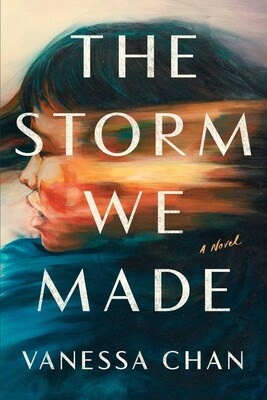 Are your grandparents still alive? Have they read the book?
Are your grandparents still alive? Have they read the book?
It's one of the sadder truths of this book that my mother, my uncle, my grandfather and my grandmother all died before it was published. My grandmother passed in January 2023, one year before publication. She was, however, around when I sold my book (I was in Malaysia at the time, for Lunar New Year in 2022). When I told her about it, she laughed, congratulated me, then instructed me to get back to sweeping the floor. Business as usual in the Chan household!
My mother was one of my first readers. When I first started writing this novel in 2020, I would shamefully post snippets on Instagram Stories, then delete them an hour later. She learned to screenshot and enlarge so she could grab the snippets as soon as I posted them. When her illness challenged her vision, I would read snippets to her on the phone before she passed.
You use the phrase "living a life of fragments" in reference to writing your novel. Your intriguing structure cleverly mirrors that fragmentation; your chapters that hop time and viewpoints are like puzzle pieces. How did you decide on this compelling format?
When I first started writing, this was actually a linear novel about three sad children living through the tail end of WWII. But as I was writing, my personal circumstances changed. As I mentioned, the pandemic happened, we were locked down, my mother passed, and I was unable to go home to be with my family. Writing about home while being unable to go home seemed like a tragic contradiction. To give myself some joy and agency, I experimented with writing about a woman who is a spy who gets to run around and make good and bad decisions. That experiment ended up becoming the emotional core of the novel: the children's flawed mother, Cecily. I realized that in order to show cause-and-effect between the children's circumstances and their mother's decisions, I'd need to write two timelines. Keeping track of it all required me to pace around my apartment muttering to myself!
What do you hope your readers might learn about Malaysia from your novel?
I always say that stories only become history when they are written down. I'm hopeful that my novel helps to build a larger awareness of Malaysia's history and its people, and the impact of WWII on Southeast Asia. But also, I'm hoping that The Storm We Made becomes a part of the burgeoning movement for more Southeast Asian literature--historical, contemporary, speculative, fantastical--whatever it is! We're seeing more novelists and writers from the region emerge, and I would love for Southeast Asian voices to take up more space.
Given Malaysia's colonial history, was anti-Japanese sentiment a part of your Malaysian childhood?
Actually, no! My grandmother always said that she draws a distinction between the government, soldiers, and civilians--and she always refused to denounce the Japanese as a people, even if she acknowledged the cruelty of the Occupation. The story of the teenage girl, Jujube, who has a friendship with a Japanese customer at her teashop, is based on my grandmother's relationship with a Japanese civilian who was kind to her and her sisters. After the war, he would write her detailed, beautiful letters, with hand-drawn maps of Japan. Then he returned to Malaysia to look for them. She told me he called down the phonebook to find their family, and then burst into tears when she and her sisters were able to reunite with him in Kuala Lumpur.
At the time of our chat, your pub date is a month away. Already, Storm has received substantial attention. What's been the biggest surprise thus far?
I never thought anyone would care about a book about Malaysia. I wrote it only because I felt compelled to, because stories call out to writers. So it's been gratifying and surprising that people want to read the book, and are sharing it with others. Readers are busybodies--the best kind. They're curious, they want to know things: history, gossip, etc. And, it seems, they are interested in Malaysia, despite my preconceptions.
What are you writing next?
I have a second book under contract with my publisher: a story collection, The Ugliest Babies in the World, about girlhood, coming of age, and how that intersects with colonialism. It's funny, it's a little bit gross, it's feral, and occasionally shocking. I've also started a new novel, but that's barely an infant. All I'll say is that it interrogates the idea of tourism--and asks the question, can one ever have an authentic experience as a tourist? --Terry Hong
Book Candy
Book Candy
For World Introvert Day (January 2), Letters of Note featured wisdom from several authors, including Fyodor Dostoevsky: "I go scarcely anywhere. Everything seems tiresome."
---
An end of year literary quiz was created by the New York Public Library's staff.
---
Merriam-Webster shared a "great big list of beautiful and useless words, vol. 1."
Rediscover
Rediscover: The Color Purple
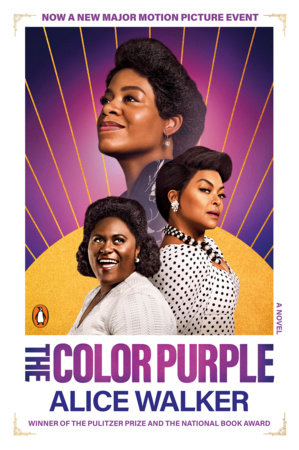 Released on Christmas Day, The Color Purple, the new musical film based on Alice Walker's 1982 iconic novel, the 1985 film, and the 2005 Broadway musical, grossed $18.2 million--the second-highest domestic opening for a film on December 25. Its box office take already totals $50 million, and it opens internationally later this month.
Released on Christmas Day, The Color Purple, the new musical film based on Alice Walker's 1982 iconic novel, the 1985 film, and the 2005 Broadway musical, grossed $18.2 million--the second-highest domestic opening for a film on December 25. Its box office take already totals $50 million, and it opens internationally later this month.
A joint production of Oprah Winfrey, Steven Spielberg, Scott Sanders, and Quincy Jones, directed by Blitz Bazawule (Black Is King), and written by Marcus Gardley (The Chi) based on the musical by Marsha Norman, The Color Purple stars Fantasia Barrino, who reprises her Broadway role as Celie; Danielle Brooks as Sofia; Taraji P. Henson as Shug Avery; Colman Domingo as Mister; H.E.R. as Squeak; Halle Bailey as Young Nettie; Corey Hawkins as Harpo; and Aunjanue Ellis-Taylor as Mama.
Whoopi Goldberg, who played Celie in the 1985 film, appears in this one as a midwife who helps young Celie give birth. Besides Goldberg and Danny Glover, another veteran from the original film is co-producer Winfrey, who played Sofia in 1985. Speaking about having a second film of The Color Purple, Winfrey said, "As long there is a need for self-discovery, self-empowerment, as long as there is a need for victory in someone's life, as long as there is a need for people to know what it feels like to be loved up and to be made full and hold to somebody else's love, there will be a need for The Color Purple."
Reviewers have mostly praised the movie. The Rotten Tomatoes' critics consensus is: "Building on the legacy of the previous film adaptation while incorporating elements of the stage musical, The Color Purple is a crowd-pleasing testament to resilience in the face of trauma." Already the film has received two Golden Globe nominations and five nominations at the Critics' Choice Awards, including Best Picture.
Still, several critics have noted that the book, which in 1983 won both the Pulitzer Prize for Fiction and the National Book Award for Fiction, offers a perspective and intimacy that film has difficulty replicating. And so we highly recommend the book, which is available from Penguin Books ($18).


